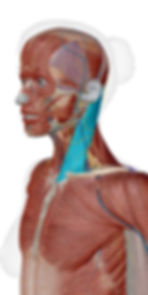The sternocleidomastoid muscle (stur-nuh-klai-duh-MAA-stoyd )

Ever wondered about the intricacies of the sternocleidomastoid (SCM) muscle?
The sternocleidomastoid muscle, often referred to as SCM, takes the spotlight as the largest muscle in the anterior part of your neck, situated just beneath the skin.
A simple touch with your fingers on both sides of your neck allows you to feel its presence, and interestingly, your pulse can be sensed through this muscle.
This muscle, consisting of two parts, embarks on a journey from the base of your neck, wrapping around both sides, and culminating at the base of your skull!
Let's Break Down The Meaning Behind The Name:

"Sterno" originates from the sternum or breastbone, and traverses both sides of the neck, merging with the clavicular head.
"Cleido" relates to the clavicle or collarbone, where the other part (the clavicular head) initiates in the center of your left and right collarbones, traveling up both sides of the neck and joining forces with the sternal head.
"Mastoid," a nod to the mastoid process, a bone section behind your ears at the skull's base, marks the termination point of the SCM muscle.
Let's delve into the functions of this fascinating muscle.

The SCM muscle serves a crucial role in enabling movement in your neck and head.
It actively engages when you:
turn
tilt
or bend your head in various directions.
Moreover, it plays a key role in maintaining your posture, aiding in breathing by lifting your breastbone and collarbone during inhalation, and supporting the temporomandibular joint (TMJ) for activities like chewing.
Check out my post - What is a TMJ Massage Treatment?
Common conditions and disorders associated with the SCM muscle.
Injuries, sprains, strains, atrophy, and tumors can impact the SCM muscle, leading to conditions like Sternocleidomastoid syndrome, temporomandibular joint disorders (TMD), and torticollis (wryneck).
These conditions may manifest as pain in various areas, including the face, forehead, eyes, cheek, ears, sinuses, throat, and shoulders, accompanied by symptoms like:
headache
dizziness
vertigo
nausea
eye changes
neck stiffness
Treatment options for the SCM muscle encompass hot or cold therapy, stretches, massage, osteopathic manipulation treatment, and physical therapy.
In severe cases, surgery may be considered.
Conclusion: Moving on to care tips for a healthy SCM muscle.
Incorporating daily neck stretches and palpating your own SCM daily, especially if you have a sedentary job, can enhance muscle flexibility and reduce the risk of injury, eye strain, and headaches. I would also have you think about:
Effectively managing stress and anxiety with weekly or monthly massage
Practicing good posture
Support your neck during exercises like sit-ups.
See if your pillow offers too much support...
And gradually raising your head during extended phone time.
In conclusion, daily gentle neck stretches and weekly stress management play pivotal roles in preventing tension and strain within your body.

